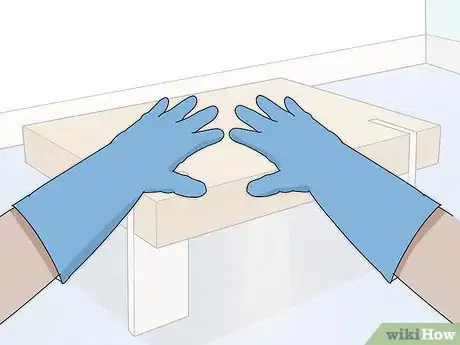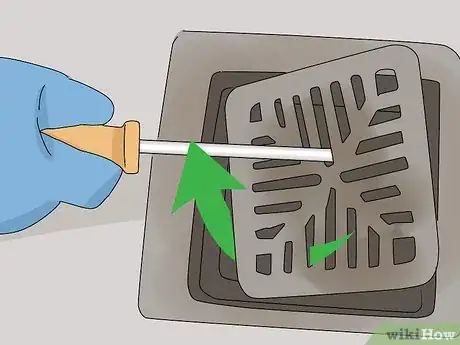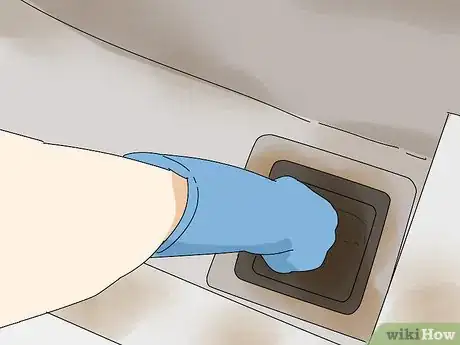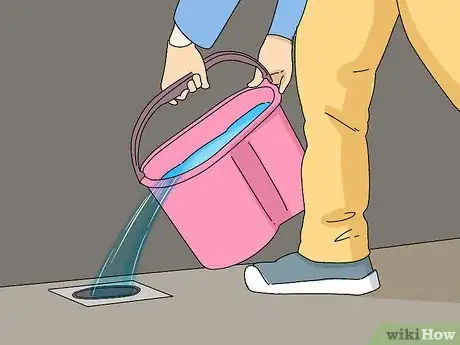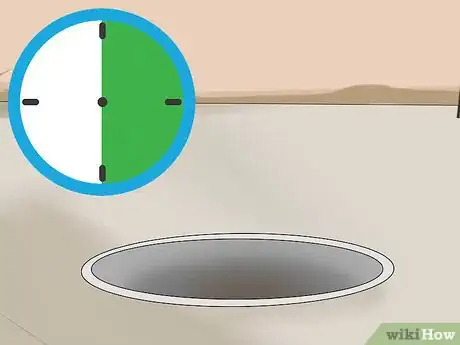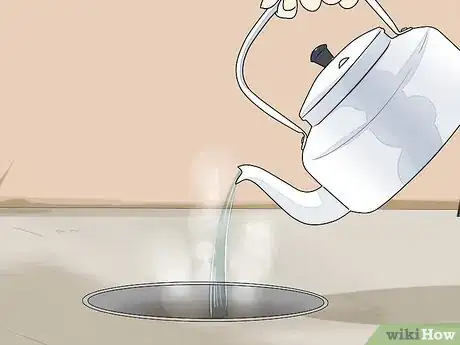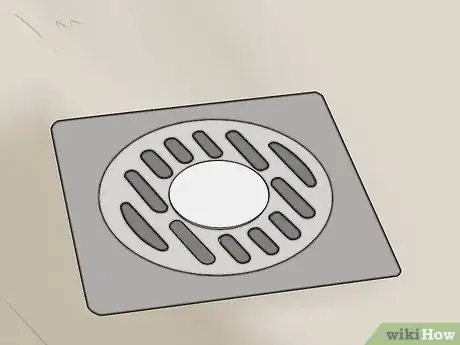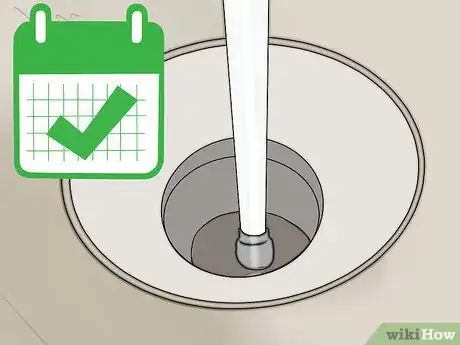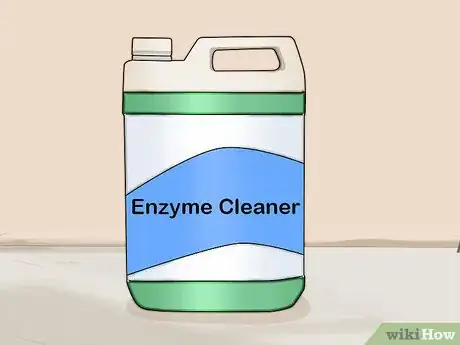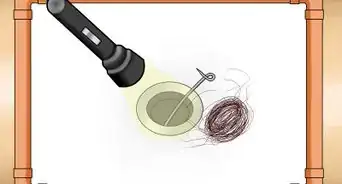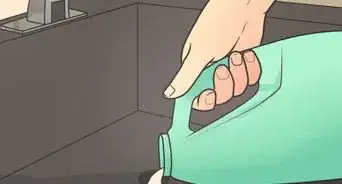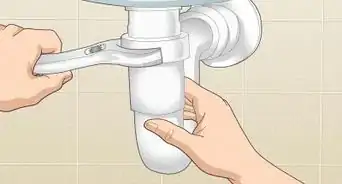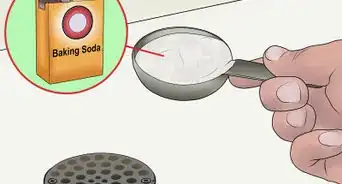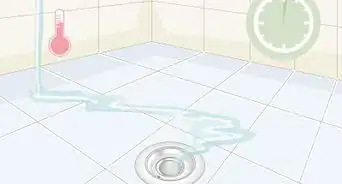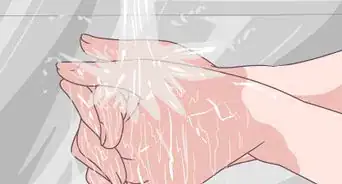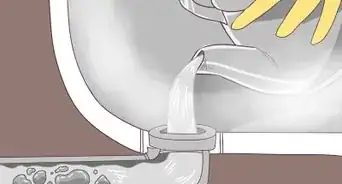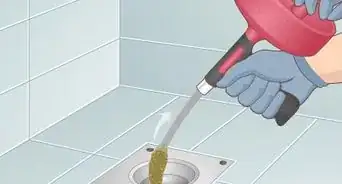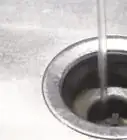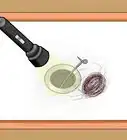This article was co-authored by David Balkan and by wikiHow staff writer, Hunter Rising. David Balkan is a Professional Plumber, CEO of Balkan Sewer and Water Main Service, and President of Balkan Sewer and Drain Cleaning. As a hands-on owner of these companies for over 40 years, David is knowledgeable about water service lines, sewers, and drain line issues. David is a Committee Chairman of the Master Plumbers Council and has sat on the Executive Committee of the Sub Surface Plumbers Association of New York for over 30 years. His knowledge and solution-oriented approach contributed to Balkan Sewer and Water Main Service being the largest and most trusted service in New York City and the recipient of the 2017 Angie’s List Super Service Award.
This article has been viewed 191,680 times.
Outdoor drains are susceptible to clogging with leaves or mud. If your drain is slow or completely backed up, there are ways you can clean it yourself without calling a plumber. Whether you break the clog apart by hand or use a solution of baking powder and vinegar, your drain will flow like new!
Steps
Breaking the Clog Apart
-
1Put on elbow-length rubber gloves before you begin. Use thick waterproof gloves that come up to your elbow. Gloves will protect your hands from anything in the water and keep your hands dry as you break the clog apart.[1]
-
2Lift the grate covering your drain with a screwdriver. Stick the end of a flathead screwdriver in between the openings of your grate. Bend the screwdriver back to pry the grate away from the drain. Set the grating aside while working inside your drain.[2]
- If the drain has a solid top, pry it up from the edge instead.
Tip: If the grate is heavy, you may need to use a grate hook to lift it. Grate hooks can be purchased from your local hardware store. Slip the end of the hook under the grate and lift it up.
Advertisement -
3Reach into the drain with your hands if you can. If your hands fit inside of the drain and you notice any obstructions, reach into the water and see if you can break apart the clog. Scoop out any debris and throw it away in a trash can. Keep scooping out the clog until you can’t pick up anymore.[3]
- Make sure you’re wearing your rubber gloves before putting your hands in the water. There may be objects hidden under the water or in the clog that could cause irritation.
-
4Use drain rods to break apart clogs you can’t reach. Drain rods are long flexible plumbing tools used to break apart blockages deep within the pipes. Feed the first rod with the rubber plunger attachment into your drain, using short bursts to force it further down. Once the rod is in the drain pipe, spin it clockwise to break apart the clog.[4]
- Drain rods can be purchased from your local hardware store.
- If there’s a solid obstruction, pull out the rod and use the corkscrew attachment instead of the plunger.
-
5Pour water and bleach into the drain to rinse out any additional debris. Spray the drain opening with 1 gallon (3.8 L) of water using your hose to test the drainage and to get rid of any loose material. Use 1–2 cups (240–470 ml) of bleach to prevent any smells and to break apart any residual obstructions.[5]
- If the drain still runs slow, use your drain rods until it works again. If you can’t get it to work, you may need to call a professional.
Using Baking Soda and Vinegar
-
1Pour 1 cup (208 g) of baking soda into the drain. Remove the grate on top of your drain so the baking soda can get into your pipes. Measure out 1 cup (208 g) of baking soda and pour it directly into the drain.[6]
- If your drain is completely clogged, consider using drain rods or a snake to break it apart first.
-
2Add 1 c (240 ml) of vinegar to the drain to start a reaction. After the baking soda, put white distilled vinegar in the drain. The vinegar will start to bubble and react with the baking soda as soon as they’re together.[7]
-
3Let the mixture sit for 30 minutes. Leave the baking soda and vinegar alone in your drain for a half hour. During this time, the baking soda and vinegar will break down organic materials stuck in your pipes and make it drain more efficiently.[8]
- Baking soda and vinegar is a great natural alternative to chemical drain cleaners.
Tip: If there's a chance of rain, cover the drain with a rag or plug so the vinegar and baking soda don't rinse out.
-
4Dump a pot of boiling water into the drain for 2 minutes. Fill a large pot two-thirds full with water and bring it to a boil on your stove. Bring the pot outside and slowly pour the water into the drain. The water helps lift any loose material inside your pipes and helps clean out the baking soda and vinegar.[9]
- Wear an oven mitt while you pour the water in case it spills down the side of the pot.
- Boiling water will kill any grass near your drain if it spills on the soil.
Preventing Clogs
-
1Cover the drain with a screen or dome to prevent large debris from falling in. Drain screens are protective grates or meshes used to keep leaves and other debris out of your pipes. Set the screen or dome over your drain so it collects any possible obstructions.[10]
- Drain covers can be purchased at your local hardware store.
- Clean your drain screens periodically to remove any obstructions.
- If the drain is in an area with a lot of foot traffic, lay down a flat rubber drain screen over it.
-
2Clean out the drain once a month so clogs cannot form. Try to clean your drains frequently, even if they aren’t clogged. Either use drain rods to break apart small obstructions or use a baking soda and vinegar treatment. With monthly maintenance, your outdoor drains won’t clog.[11]
- If you have severe storms, check your drains the following day to see if there is any debris.
-
3Use a biological enzyme cleaner when your drain is running slow. Biological enzymes use natural bacteria to break down organic materials in your pipes. Wait until a clear evening when you aren’t expecting rain in your area. Pour the entire bag of the enzyme into your drain and let it work overnight.[12]
- Enzyme cleaners come in liquid or granular form and can be purchased online or from your local hardware store.
Tip: Enzyme cleaners are safe to use with septic tank lines since they won't harm the helpful bacteria. If you have a clog in a septic drain, try enzyme cleaners before any harsh chemicals.
Expert Q&A
-
QuestionHow can I clear a drain outside on my own?
 David BalkanDavid Balkan is a Professional Plumber, CEO of Balkan Sewer and Water Main Service, and President of Balkan Sewer and Drain Cleaning. As a hands-on owner of these companies for over 40 years, David is knowledgeable about water service lines, sewers, and drain line issues. David is a Committee Chairman of the Master Plumbers Council and has sat on the Executive Committee of the Sub Surface Plumbers Association of New York for over 30 years. His knowledge and solution-oriented approach contributed to Balkan Sewer and Water Main Service being the largest and most trusted service in New York City and the recipient of the 2017 Angie’s List Super Service Award.
David BalkanDavid Balkan is a Professional Plumber, CEO of Balkan Sewer and Water Main Service, and President of Balkan Sewer and Drain Cleaning. As a hands-on owner of these companies for over 40 years, David is knowledgeable about water service lines, sewers, and drain line issues. David is a Committee Chairman of the Master Plumbers Council and has sat on the Executive Committee of the Sub Surface Plumbers Association of New York for over 30 years. His knowledge and solution-oriented approach contributed to Balkan Sewer and Water Main Service being the largest and most trusted service in New York City and the recipient of the 2017 Angie’s List Super Service Award.
Professional Plumber & CEO of Balkan Sewer & Water Main You really need to call a professional for that. The lines are larger outside, so you really need a professional-sized snake. If that doesn't work, the professional can use other tools, like high-pressure water jets.
You really need to call a professional for that. The lines are larger outside, so you really need a professional-sized snake. If that doesn't work, the professional can use other tools, like high-pressure water jets. -
QuestionHow do you unblock an external drain?
 Drew Hawkins1Community AnswerYou can unblock an external or outdoor drain by lifting up the grate covering it and breaking up the clog with your hands or a drain rod if you can reach it. After you break up the clog, pour about 1 gallon (3.8 L) of water down the drain using your hose to test the drainage and to get rid of any loose material. Then, use 1–2 cups (240–470 ml) of bleach to prevent any smells and to break apart any residual obstructions.
Drew Hawkins1Community AnswerYou can unblock an external or outdoor drain by lifting up the grate covering it and breaking up the clog with your hands or a drain rod if you can reach it. After you break up the clog, pour about 1 gallon (3.8 L) of water down the drain using your hose to test the drainage and to get rid of any loose material. Then, use 1–2 cups (240–470 ml) of bleach to prevent any smells and to break apart any residual obstructions. -
QuestionWhat can I put down outside drains?
 Drew Hawkins1Community AnswerYou can stick drain rods down outside drains to try to break up clogs or obstructions that may be blocking it. You can also pour 1 cup (208 g) of baking soda into the drain, then pour 1 cup (240 ml) of vinegar to the drain to start a reaction that will unclog the drain. Let the mixture sit for about 30 minutes, then pour a large pot of boiling water down the drain to lift loose material and flush the clog down the drain.
Drew Hawkins1Community AnswerYou can stick drain rods down outside drains to try to break up clogs or obstructions that may be blocking it. You can also pour 1 cup (208 g) of baking soda into the drain, then pour 1 cup (240 ml) of vinegar to the drain to start a reaction that will unclog the drain. Let the mixture sit for about 30 minutes, then pour a large pot of boiling water down the drain to lift loose material and flush the clog down the drain.
Warnings
- Wear rubber gloves when you’re working on your drain so you don’t get any skin irritation from the water or debris.⧼thumbs_response⧽
Things You’ll Need
Breaking the Clog Apart
- Rubber gloves
- Screwdriver
- Drain rods
- Hose
- Bleach
Using Caustic Soda
- Baking soda
- Vinegar
- Large pot
- Stove
Preventing Clogs
- Drain screen or dome
- Biological enzyme cleaner
References
- ↑ https://youtu.be/tcENspLLeeU?t=36
- ↑ https://drainagenetworks.co.uk/ways-to-unblock-an-outside-drain/
- ↑ https://youtu.be/tcENspLLeeU?t=69
- ↑ https://youtu.be/iGybr5-jiTc?t=93
- ↑ https://drainagenetworks.co.uk/ways-to-unblock-an-outside-drain/
- ↑ https://drainagenetworks.co.uk/ways-to-unblock-an-outside-drain/
- ↑ https://drainagenetworks.co.uk/ways-to-unblock-an-outside-drain/
- ↑ https://greenerideal.com/guides/4-ways-to-unclog-a-drain-naturally/#3_Baking_Soda_and_Vinegar
- ↑ https://greenerideal.com/guides/4-ways-to-unclog-a-drain-naturally/#3_Baking_Soda_and_Vinegar
